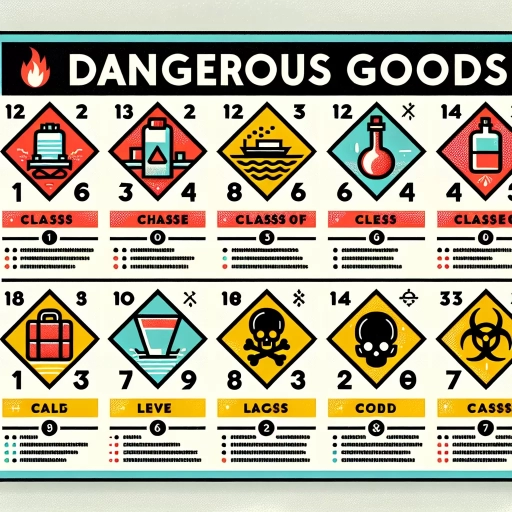How Many Classes Of Dangerous Goods Are There

Understanding Dangerous Goods and Their Classification
The Concept of Dangerous Goods
Dangerous goods, also referred to as hazardous materials, are substances that can potentially cause harm to people, property, or the environment. They are typically characterized by their corrosive, flammable, explosive, poisonous, infectious, or radioactive properties. The transportation, handling, and storage of such substances demand stringent regulations to prevent accidents and maintain safety. From common household items such as batteries and aerosols to industrial substances like acids and flammable liquids, the gamut of dangerous goods is wide and varied.
Importance of Dangerous Goods Classification
The classification of dangerous goods is a critical aspect of their handling. The nature of the hazard they pose determines the method and care with which they are to be transported and stored. Understanding the class of a dangerous good helps in devising safety measures and response strategies in case of emergent situations. Inadequate knowledge or ignorance of this classification can result in incidents leading to material damage, environmental pollution, injury, or even loss of life.
The Genesis of Dangerous Goods Classification
The classification system for dangerous goods has its roots in the work of international organizations dedicated to regulating their transport and storage. This system aims at harmonizing and standardizing safety measures across regions and modes of transport. While the broad structure of the classification is universally accepted, specific regulations might differ considering the regional or national legislation.
Detailed Breakdown of Dangerous Goods Classes
Class 1: Explosives
Explosives form the first class of dangerous goods. These substances have the ability to rapidly decompose or react in a violent manner, leading to an explosion. Given their nature, strict safety protocols govern their handling. Explosives are further divided into six divisions depending upon their potential risk. These range from substances and articles with a mass explosion hazard (Division 1.1) to extremely insensitive articles that do not carry a mass explosion risk (Division 1.6).
Class 2: Gases
Gases, including compressed gases, liquefied gases, and refrigerated liquefied gases, constitute the second class of dangerous goods. The risk these gases pose includes flammability, explosiveness, toxicity, corrosivity, and the potential to undergo sudden pressure increase. Proper packaging and handling, therefore, become important in their transportation and storage.
Class 3: Flammable Liquids
Flammable liquids come under the third class of dangerous goods. The prominent risk with these substances is their ability to catch fire. They are characterized by their low flash points, due to which they can ignite at relatively low temperatures. However, like the other classes, flammable liquids also have subgroup classifications depending on their exact properties and risks.
Further Exploration of Dangerous Goods Classes
Classes 4 to 9: Various Types of Substances
Other classes of dangerous goods include flammable solids, oxidizing substances, toxic and infectious substances, radioactive materials, corrosives, and several other hazard types that do not fall under the previous eight classes. Each of these classes makes up for a specific danger, needing specific measures to contain and handle them safely.
Strict Regulations Govern Dangerous Goods
The handling and transportation of these goods are governed by some strict regulations. These regulations are put in place to prevent any instances of accidents and to ensure the safety of everyone involved. They cover all aspects from the production, packing, loading, carrying, and unloading of these goods.
The Role of Training in Handling Dangerous Goods
Dangerous goods handling is a critical field where training plays a vital role. Anyone involved in the packing, loading, carrying, or handling of these goods needs to be properly trained in understanding their risks, safety protocols, emergency procedures, and mitigation strategies in case of an incident. This not only ensures their safety but also the safety of the environment.